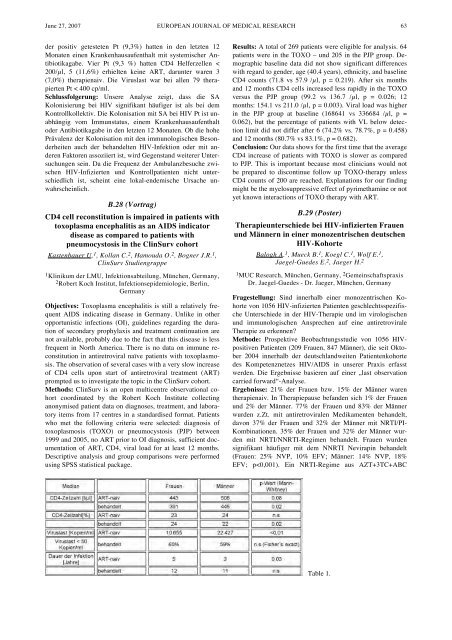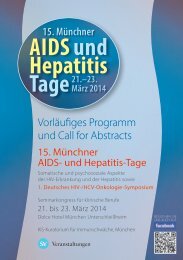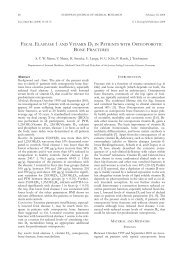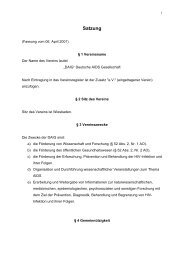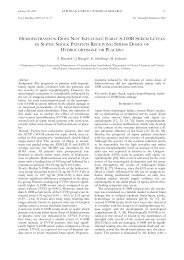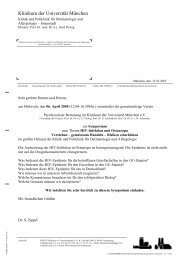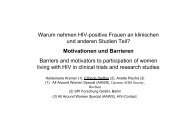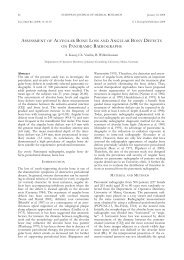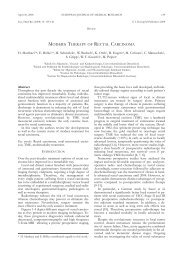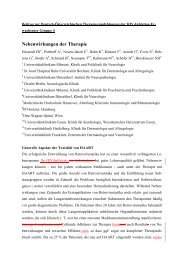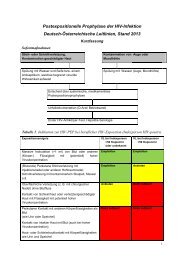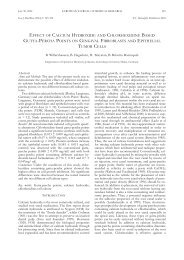European Journal of Medical Research - Deutsche AIDS ...
European Journal of Medical Research - Deutsche AIDS ...
European Journal of Medical Research - Deutsche AIDS ...
Create successful ePaper yourself
Turn your PDF publications into a flip-book with our unique Google optimized e-Paper software.
June 27, 2007 EUROPEAN JOURNAL OF MEDICAL RESEARCH<br />
63<br />
der positiv getesteten Pt (9,3%) hatten in den letzten 12<br />
Monaten einen Krankenhausaufenthalt mit systemischer Antibiotikagabe.<br />
Vier Pt (9,3 %) hatten CD4 Helferzellen <<br />
200/�l, 5 (11,6%) erhielten keine ART, darunter waren 3<br />
(7,0%) therapienaiv. Die Viruslast war bei allen 79 therapierten<br />
Pt < 400 cp/ml.<br />
Schlussfolgerung: Unsere Analyse zeigt, dass die SA<br />
Kolonisierung bei HIV signifikant häufiger ist als bei dem<br />
Kontrollkollektiv. Die Kolonisation mit SA bei HIV Pt ist unabhängig<br />
vom Immunstatus, einem Krankenhausaufenthalt<br />
oder Antibiotikagabe in den letzten 12 Monaten. Ob die hohe<br />
Prävalenz der Kolonisation mit den immunologischen Besonderheiten<br />
auch der behandelten HIV-Infektion oder mit anderen<br />
Faktoren assoziiert ist, wird Gegenstand weiterer Untersuchungen<br />
sein. Da die Frequenz der Ambulanzbesuche zwischen<br />
HIV-Infizierten und Kontrollpatienten nicht unterschiedlich<br />
ist, scheint eine lokal-endemische Ursache unwahrscheinlich.<br />
B.28 (Vortrag)<br />
CD4 cell reconstitution is impaired in patients with<br />
toxoplasma encephalitis as an <strong>AIDS</strong> indicator<br />
disease as compared to patients with<br />
pneumocystosis in the ClinSurv cohort<br />
Kastenbauer U. 1 , Kollan C. 2 , Hamouda O. 2 , Bogner J.R. 1 ,<br />
ClinSurv Studiengruppe<br />
1 Klinikum der LMU, Infektionsabteilung, München, Germany,<br />
2 Robert Koch Institut, Infektionsepidemiologie, Berlin,<br />
Germany<br />
Objectives: Toxoplasma encephalitis is still a relatively frequent<br />
<strong>AIDS</strong> indicating disease in Germany. Unlike in other<br />
opportunistic infections (OI), guidelines regarding the duration<br />
<strong>of</strong> secondary prophylaxis and treatment continuation are<br />
not available, probably due to the fact that this disease is less<br />
frequent in North America. There is no data on immune reconstitution<br />
in antiretroviral naïve patients with toxoplasmosis.<br />
The observation <strong>of</strong> several cases with a very slow increase<br />
<strong>of</strong> CD4 cells upon start <strong>of</strong> antiretroviral treatment (ART)<br />
prompted us to investigate the topic in the ClinSurv cohort.<br />
Methods: ClinSurv is an open multicentre observational cohort<br />
coordinated by the Robert Koch Institute collecting<br />
anonymised patient data on diagnoses, treatment, and laboratory<br />
items from 17 centres in a standardised format. Patients<br />
who met the following criteria were selected: diagnosis <strong>of</strong><br />
toxoplasmosis (TOXO) or pneumocystosis (PJP) between<br />
1999 and 2005, no ART prior to OI diagnosis, sufficient documentation<br />
<strong>of</strong> ART, CD4, viral load for at least 12 months.<br />
Descriptive analysis and group comparisons were performed<br />
using SPSS statistical package.<br />
Results: A total <strong>of</strong> 269 patients were eligible for analysis. 64<br />
patients were in the TOXO – und 205 in the PJP group. Demographic<br />
baseline data did not show significant differences<br />
with regard to gender, age (40.4 years), ethnicity, and baseline<br />
CD4 counts (71.8 vs 57.9 /�l, p = 0.219). After six months<br />
and 12 months CD4 cells increased less rapidly in the TOXO<br />
versus the PJP group (99.2 vs 136.7 /�l, p = 0.026; 12<br />
months: 154.1 vs 211.0 /�l, p = 0.003). Viral load was higher<br />
in the PJP group at baseline (168641 vs 336684 /�l, p =<br />
0.062), but the percentage <strong>of</strong> patients with VL below detection<br />
limit did not differ after 6 (74.2% vs. 78.7%, p = 0.458)<br />
and 12 months (80.7% vs 83.1%, p = 0.682).<br />
Conclusion: Our data shows for the first time that the average<br />
CD4 increase <strong>of</strong> patients with TOXO is slower as compared<br />
to PJP. This is important because most clinicians would not<br />
be prepared to discontinue follow up TOXO-therapy unless<br />
CD4 counts <strong>of</strong> 200 are reached. Explanations for our finding<br />
might be the myelosuppressive effect <strong>of</strong> pyrimethamine or not<br />
yet known interactions <strong>of</strong> TOXO therapy with ART.<br />
B.29 (Poster)<br />
Therapieunterschiede bei HIV-infizierten Frauen<br />
und Männern in einer monozentrischen deutschen<br />
HIV-Kohorte<br />
Balogh A. 1 , Mueck B. 1 , Koegl C. 1 , Wolf E. 1 ,<br />
Jaegel-Guedes E. 2 , Jaeger H. 2<br />
1 MUC <strong>Research</strong>, München, Germany, 2 Gemeinschaftspraxis<br />
Dr. Jaegel-Guedes - Dr. Jaeger, München, Germany<br />
Fragestellung: Sind innerhalb einer monozentrischen Kohorte<br />
von 1056 HIV-infizierten Patienten geschlechtsspezifische<br />
Unterschiede in der HIV-Therapie und im virologischen<br />
und immunologischen Ansprechen auf eine antiretrovirale<br />
Therapie zu erkennen?<br />
Methode: Prospektive Beobachtungsstudie von 1056 HIVpositiven<br />
Patienten (209 Frauen, 847 Männer), die seit Oktober<br />
2004 innerhalb der deutschlandweiten Patientenkohorte<br />
des Kompetenznetzes HIV/<strong>AIDS</strong> in unserer Praxis erfasst<br />
werden. Die Ergebnisse basieren auf einer „last observation<br />
carried forward“-Analyse.<br />
Ergebnisse: 21% der Frauen bzw. 15% der Männer waren<br />
therapienaiv. In Therapiepause befanden sich 1% der Frauen<br />
und 2% der Männer. 77% der Frauen und 83% der Männer<br />
wurden z.Zt. mit antiretroviralen Medikamenten behandelt,<br />
davon 37% der Frauen und 32% der Männer mit NRTI/PI-<br />
Kombinationen. 35% der Frauen und 32% der Männer wurden<br />
mit NRTI/NNRTI-Regimen behandelt. Frauen wurden<br />
signifikant häufiger mit dem NNRTI Nevirapin behandelt<br />
(Frauen: 25% NVP, 10% EFV; Männer: 14% NVP, 18%<br />
EFV; p


